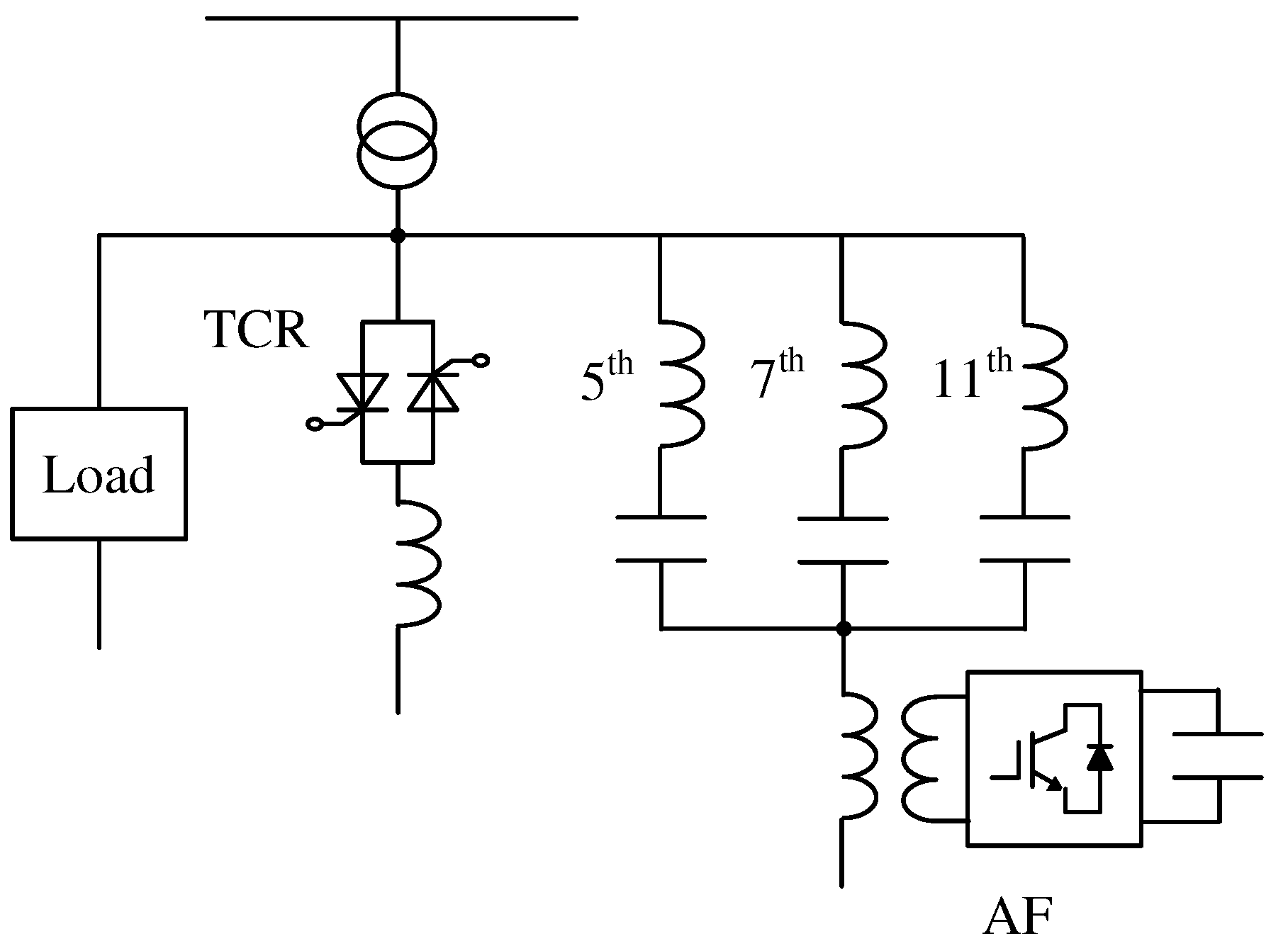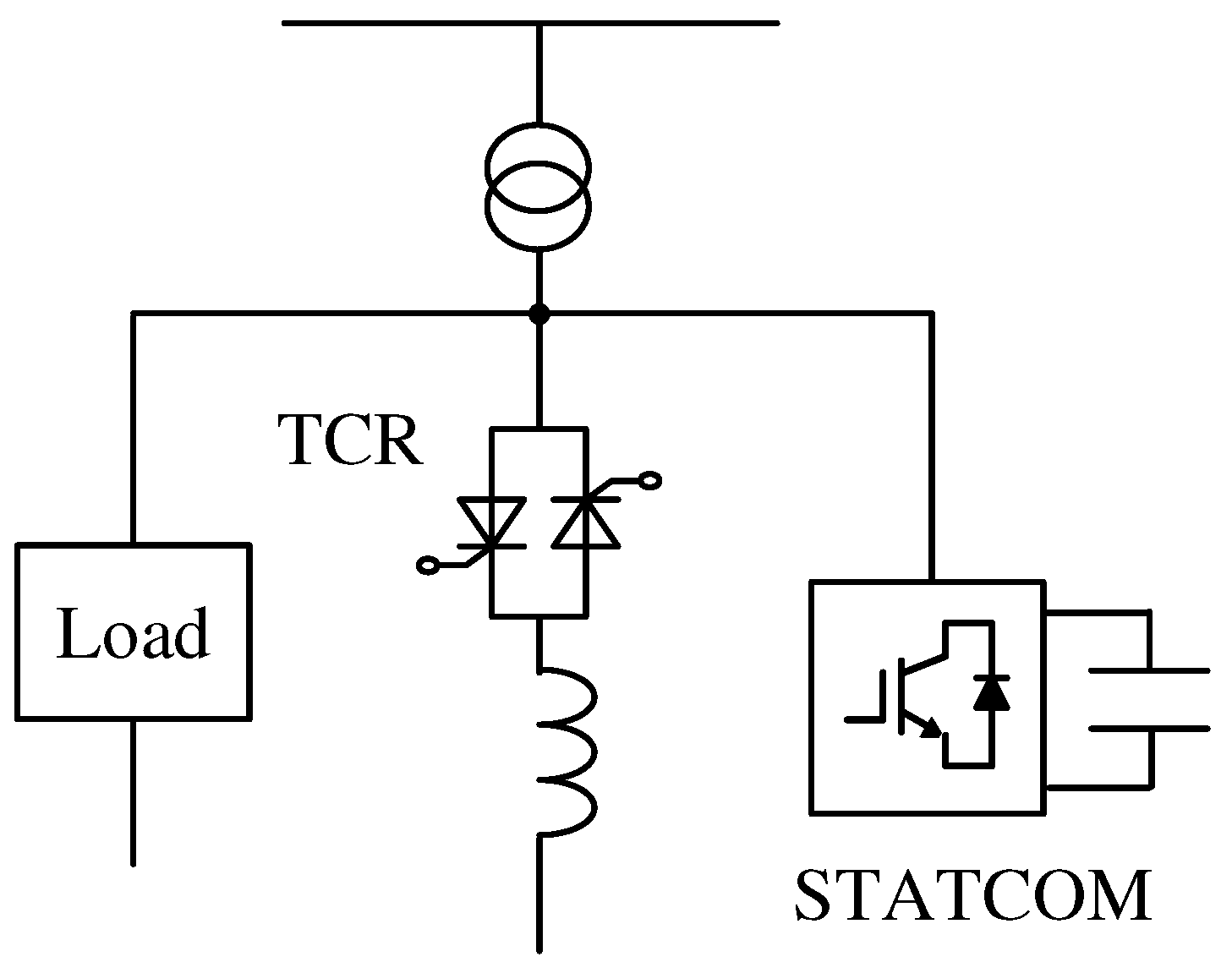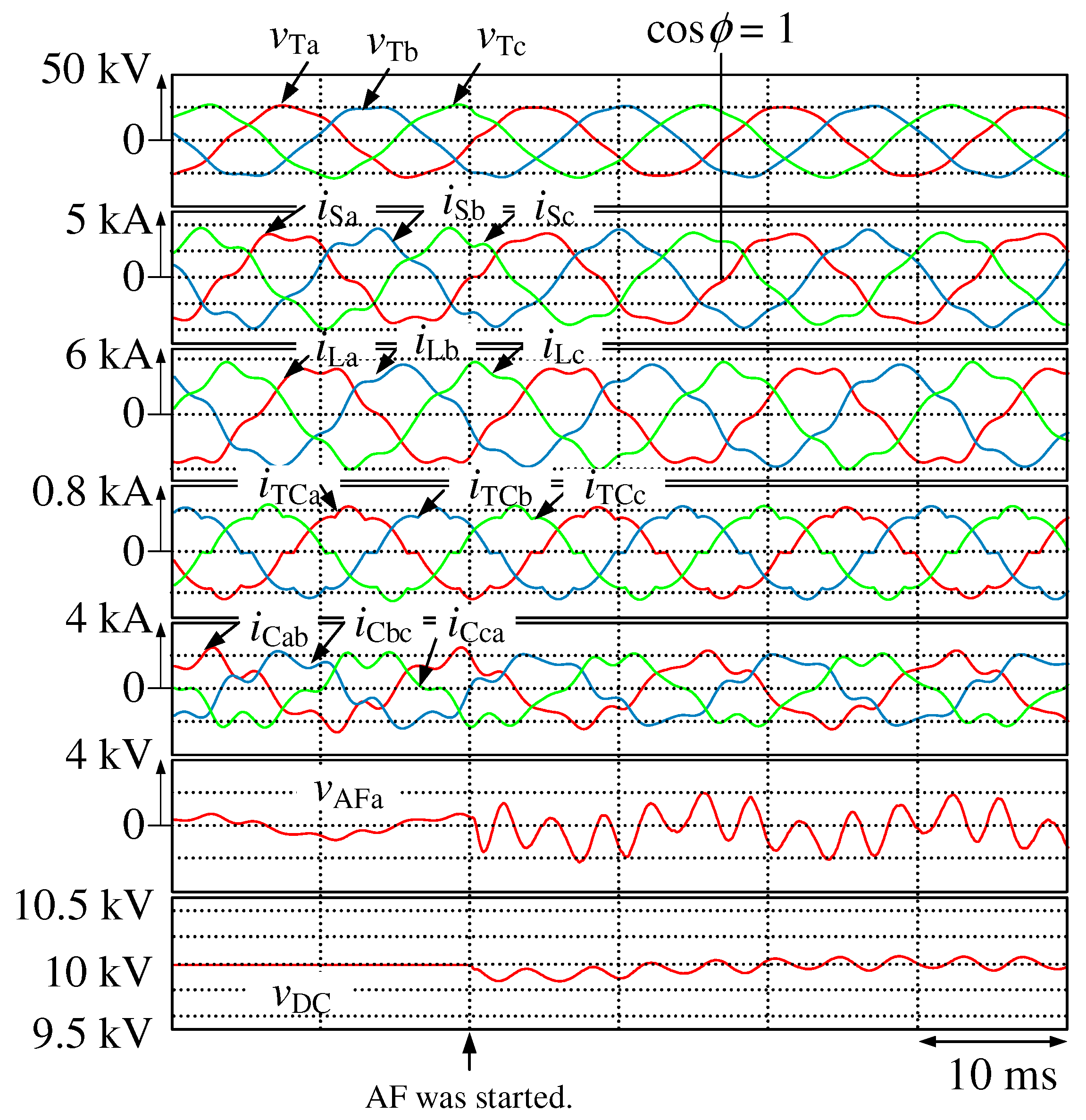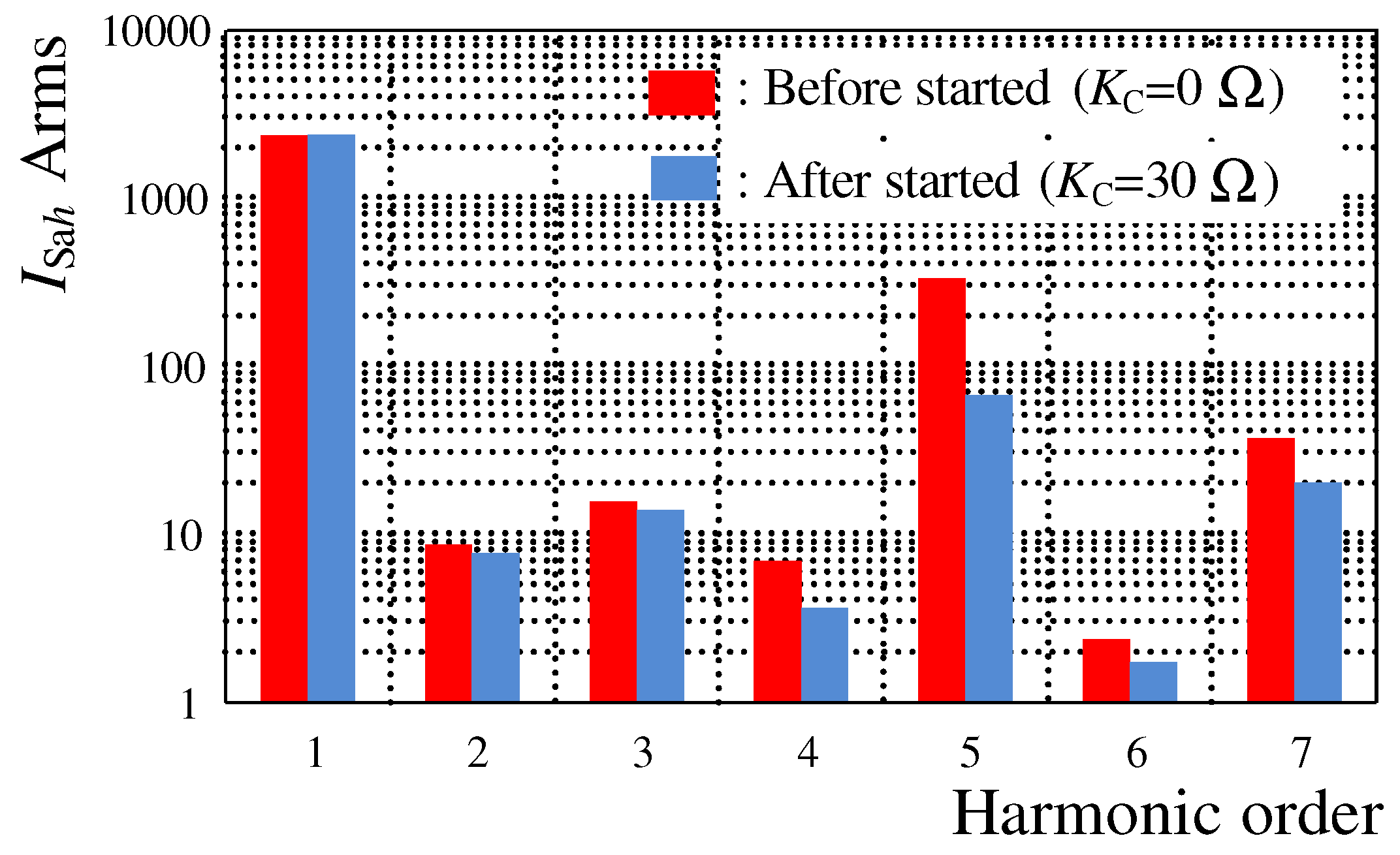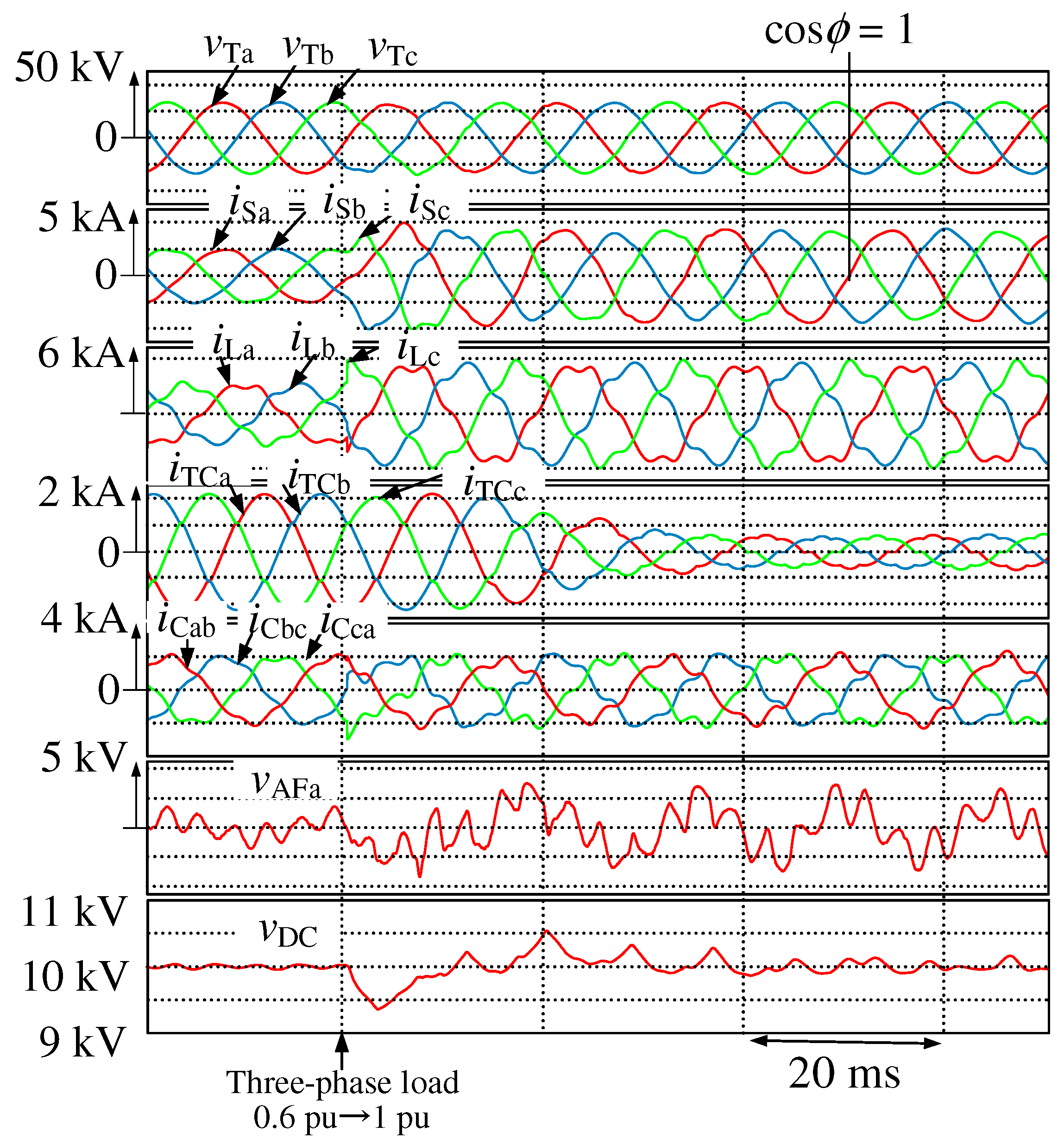1. Introduction
Large-capacity electric arc furnaces and rolling mills cause rapid reactive-power fluctuations in distribution feeders. These rapid reactive-power fluctuations lead to reactive-power interferences such as flickers and voltage fluctuations in distribution feeders. Static VAR compensators (SVCs) with thyristor-controlled reactors (TCRs) and phase-leading capacitors (PLCs) are widely used to solve the reactive-power interferences in distribution feeders because of low costs [
1]. However, TCRs generate harmonic currents on the source side [
2]. Many topologies have been proposed to improve the compensation characteristics of the source-side harmonic currents for SVCs [
3,
4,
5,
6]. The passive filters, which consist of the 5th-, 7th-, and 11th-tuned filters, are combined with the TCR. A three-phase current-controlled voltage-source pulse-width-modulated (PWM) inverter is connected in series to the passive LC filters through matching transformers (MTs). The series-connected three-phase current-controlled voltage-source PWM inverter improves the compensation characteristics of the passive filters.
Hybrid active filters (AFs) have also been proposed by many researchers [
7,
8,
9,
10,
11]. The previously proposed hybrid AF topologies are essentially a series connection of the LC tuned filters and a three-phase shunt AF. The rating of the shunt AF can be reduced because the fundamental reactive and designated-order harmonic currents are compensated for by the series-connected LC tuned filters. A hybrid SVC topology with the hybrid AF has been proposed [
12,
13]. The PLCs with TCRs control the fundamental reactive power on the source side. As the shunt AF compensates only for harmonic currents, the required rating of the shunt AF is low. In [
14], a static synchronous compensator (STATCOM) is combined with TCRs. The STATCOM performs with PLCs compensating for harmonic currents on the source side. Thus, the required rating of the parallel-connected STATCOM is high. A combined system of shunt-passive and series AFs has also been proposed [
15,
16,
17]. While the proposed topologies are practical and cost-effective, the fundamental reactive power on the source side cannot be controlled. Thus, a hybrid SVC topology consisting of TCRs and pure PLCs with a small-rated voltage-source PWM inverter has not been reported, as far as the authors know.
This paper proposes a new hybrid SVC topology comprising a small-rated series AF and SVC, which consists of TCRs and pure PLCs. The series AF is connected in series to the pure PLCs. In [
17], Prof. H. Fujita, et al. proposed a combined system consisting of a shunt-passive filter and series AF for a current-source harmonic-producing load. The series AF performs for a resistor of
for source-side harmonic currents. We note that there are two current-source harmonic-producing loads, namely, the TCR and the three-phase load, in the newly proposed hybrid SVC. Considering both the three-phase load and the TCR as a current-source harmonic-producing load, the previously proposed control strategy for the series AF in [
17] is applicable to the newly proposed hybrid SVC. This is a simple and practical idea for the control strategy of the series AF in the newly proposed hybrid SVC. Thus, the series AF in the proposed hybrid SVC performs for a resistor of
for source-side harmonic currents. The source-side harmonic currents are isolated by the series AF, while PLCs with TCRs compensate for the fundamental reactive currents on the source side. Sinusoidal source currents with a unity power factor are achieved by the newly proposed hybrid SVC. The basic principle of the proposed hybrid SVC is discussed in detail. The compensation characteristics of the harmonic currents are shown in detail, and these have been confirmed by digital computer simulation using PSIM software. The simulation results demonstrate that sinusoidal source currents with a unity power factor are obtained. From the simulation results, the required capacity of the series AF is 2.8% as compared to the rating of the three-phase load. The addition of the small-rated series AF isolates the source-side harmonics perfectly. Only the newly proposed topology can be applied to the SVCs that are under commercial operations, although the required rating of the series AF is slightly higher than that of the series AF in [
3,
4,
5,
6]. This demonstrates that the proposed hybrid SVC is useful and cost-effective for practical distribution feeders.
2. Previously Proposed Topologies of the Hybrid Static VAR Compensator
Figure 1 shows a power circuit diagram of the previously proposed hybrid SVC topology [
3,
4,
5,
6]. The previously proposed hybrid SVC topology consists of TCRs and 5th-, 7th-, and 11th-tuned filters with series-connected AFs. In [
3], the added series AF performs for a resistor for the source-side currents. The purpose of the series AF is to suppress the anti-resonance between the LC tuned filters and source impedance.
The source-side harmonic current compensations with the series AF under normal operation were not discussed or demonstrated. In [
4,
5,
6], the added series AFs perform as current sources for harmonic currents, which flow into the LC tuned filters. This injection improves the compensation characteristics of the LC tuned filters. The required rating of the series AF was 1.4% as compared to the rating of the three-phase load. The previously proposed hybrid SVC topology in
Figure 1, however, cannot be applied to the SVCs that are under commercial operations, because PLCs should be replaced by the LC tuned filters.
Figure 2 shows a power circuit diagram of the previously proposed hybrid SVC topology [
12,
13]. The PLCs with TCRs control the fundamental reactive power on the source side. The inductors are connected in series to the PLCs with TCRs. These allow the fifth-tuned LC filters to sink the fifth-harmonics generated by the load. The shunt AFs inject the harmonic currents. Thus, the shunt AFs improve the compensation characteristics of the fifth-tuned filters. The required rating of the shunt AFs was 4.0% as compared to the rating of the three-phase load. The previously proposed hybrid SVC topology is not applicable to the SVCs that are under commercial operations, because the conventional PLCs with TCRs also should be replaced with those shown in
Figure 2.
Figure 3 shows a power circuit diagram of the previously proposed hybrid SVC with the STATCOM [
14]. The STATCOM performs with PLCs compensating for harmonic currents on the source side. Thus, the required rating of the parallel-connected STATCOM is much higher than those of the added AFs in
Figure 1 and
Figure 2. In [
14], the required rating of the STATCOM is 80% as compared to the rating of the three-phase load. Using a large capacity, the STATCOM results in a high-cost hybrid SVC.
Table 1 shows summaries of the previously proposed hybrid SVC. As described in the Introduction, a hybrid SVC topology with a small-rated voltage-source PWM inverter, which can be applied to the conventional SVC consisting of TCRs and pure PLCs, has not been reported, as far as the authors know.
3. Newly Proposed Hybrid Static VAR Compensator
Figure 4 shows a circuit diagram of the proposed hybrid SVC.
Table 2 shows circuit constants for
Figure 4, which are used in the following simulation results. The proposed hybrid SVC comprises a series AF and SVC, which consists of the
-connected TCR and
-connected pure PLCs. The series AF consists of a three-phase voltage-source PWM inverter with insulated-gate bipolar transistors (IGBTs). The series AF is connected in series to the three-phase PLCs through MTs, where the turns ratio is 1:2. The small-rated LC filter (inducer
and capacitor
) suppresses switching ripples that are generated by the PWM inverter, which performs for the series AF. The purpose of this paper is to demonstrate the compensation performance of the reactive and harmonic currents for the proposed hybrid SVC. Thus, ideal models for IGBTs, inductors, and capacitors are used.
Table 3 shows data for the MTs used in
Figure 4. Leakage inductors, winding resistors, and magnetizing admittance are considered in the MT model of
Figure 4. A three-phase load generates the fundamental reactive currents, and fifth- and seventh-order harmonic currents. A three-phase current source is used to demonstrate the three-phase load. The authors, who are with the Chugoku Electric Manufacturing Company, have had extensive experience with developing commercial SVCs and selling SVCs to customers. Generally, the capacities of TCRs and PLCs are decided by considering the true load conditions of the customers. Thus, the capacities of TCRs and PLCs were decided with the published paper [
18].
The rating of the three-phase load is 176 MVA. The rating of the three-phase source voltage is 33 kVrms, 60 Hz, while the rating of the inductor of the TCRs is 80 MVA and that of the PLCs is 140 MVA. Thus, the per-phase base rated current and impedance are 3.1 kArms and 6.2 , which are both 1 pu. The pure PLCs with TCRs compensate for the fundamental reactive power on the source side. The series AF performs for a resistor of . The source-side harmonic currents are isolated by the series AF, while PLCs with TCRs compensate for the fundamental reactive currents on the source side. Sinusoidal source currents with a unity power factor are achieved by the newly proposed hybrid SVC.
Figure 5 shows per-phase equivalent circuits for
Figure 4.
Figure 5a shows a per-phase equivalent circuit for
Figure 4, where
is the source voltage,
is the source current,
is the load current,
is the TCR current,
is the PLC current,
is the output value of the series AF,
is the source-side impedance, and
is the impedance of a per-phase PLC. The three-phase load generates the fundamental reactive currents and harmonic currents. TCRs with PLCs compensate for the fundamental reactive currents. However, TCRs also generate harmonic currents. Thus, there are two current-source harmonic-producing loads, namely, the TCR and three-phase load, in
Figure 5a. Harmonic currents generated by both the three-phase load and TCRs flow into PLCs and the source voltage
. Thus, the three-phase load and TCRs are considered by a current-source harmonic-producing load.
Figure 5b shows a per-phase equivalent circuit for
Figure 5a, where
is the sum of
generated by the TCR and
generated by the three-phase load. Professor H. Fujita et al. proposed a combined system of a shunt-passive filter and series AF for the current-source harmonic-producing load, which is a large-capacity thyristor rectifier, with a novel control method of the series AF [
17]. The control method proposed in [
17] is applicable for
Figure 4 because two current-source harmonic-producing loads, namely, the TCR and three-phase load, can be considered as a current-source harmonic-producing load, as shown in
Figure 5b. The series AF performs for a resistor of
for the harmonic source currents. The output voltage
of the series AF in
Figure 5b is given by
When no harmonics are included in the source voltage
, a per-phase base equivalent circuit for load-side harmonic currents is shown in
Figure 5c. In
Figure 5c, the source-side harmonic current
is given by
If
in Equation (
2),
Thus, the sinusoidal source currents
,
, and
are obtained with the series AF connected to the pure PLCs. The transfer function
G(
s) of the low-pass filter (LPF) in
Figure 4 is considered in Equation (
2). The transfer function
G(
s) of the LPF is expressed as
where
. The cut-off frequency
is 179 Hz, and the damping factor
is 0.7. With the transfer function
G(
s), the source-side harmonic currents
are rewritten as
Figure 6a shows gain plots for
Figure 5c, where the source-side impedance
pu. In
Figure 6,
is the source-voltage frequency, which is 60 Hz. As described before, the per-phase rated impedance is 6.2
in
Figure 4. To satisfy that
in Equation (
2), the control gain
is varied from 10 to 30
. The line with
shows the compensation characteristics for the source-side harmonic currents when the series AF is not connected. From the second- to fifth-order components, the gains are positive. This means that the harmonic currents
generated by the TCRs and three-phase load are magnified on the source side. Increasing the control gain
suppresses the harmonic current magnifications on the source side. In particular, when
is 30
, there is no positive area for the fundamental and harmonic components. Thus, the series AF with the control gain
of 30
perfectly isolates the harmonic currents generated by both the TCRs and the three-phase load on the source side. The sinusoidal source currents with a unity power factor are obtained with the proposed hybrid SVC.
Figure 5d shows a per-phase base equivalent circuit for the source-voltage harmonics
. In
Figure 5d,
is expressed by
Figure 6b shows gain plots for
Figure 5d. The line with
shows the compensation characteristics for the source-side harmonic voltages
when the series AF is not connected. From the third- to fourth-order components, the source-side harmonic current
flows into the PLC. The lines with
show the compensation characteristics for the source-side harmonic voltages
with the series AF. The source-side harmonic currents
are isolated by the series AF in the proposed hybrid SVC. Therefore, sinusoidal source currents with a unity power factor are obtained with the proposed hybrid SVC. We note that no fundamental source voltage appears across the series AF, and this results in a significant reduction in the required rating of the series AF.
Here, the control strategy of the series AF in the time domain, which was proposed in [
17], is briefly introduced. A three-phase phase-locked loop (PLL) is used to detect the electric angle
of a-phase PLC current [
19]. Here, only the PLC currents are detected to generate the electric angle
. The terminal voltages
,
, and
are not detected. Thus, any sensors for the external voltages detections are not needed in the proposed hybrid SVC shown in
Figure 4. The firing angle of the TCR is also controlled using the electric angle
.
The source currents
,
, and
are expressed as
Three-phase source currents,
,
, and
are detected, and then the detected source currents are transformed into
d-
q coordinates. Generally, to transform
,
, and
into
d-
q coordinates, the electric angle
of a-phase terminal voltage
is required. In
Figure 4,
+
equals
. Using the detected electric angle
,
and
can be calculated;
and
are given by
The DC components
and
in
d-
q coordinates originate from the fundamental components
,
, and
of the source currents
,
, and
, respectively, in a-b-c coordinates. The AC components
and
in
d-
q coordinates originate from the harmonic currents
,
, and
of the source currents. These AC components are extracted by high-pass filters (HPFs) with a second-order LPF. The extracted AC components are then retransformed into a-b-c coordinates. Retransforming
and
into a-b-c coordinates gives the source-side harmonic currents
,
, and
. With the extracted source-side harmonic currents
,
, and
, the reference values
,
, and
for the series AF are given by
Therefore, the series AF performs for a resistor of for source-side harmonic currents , , and . A sine-triangle intercept technique is used to generate the gate signals for the three-phase voltage-source PWM inverter. The switching frequency of the three-phase voltage-source PWM inverter is 12 kHz.
4. Simulation Results
The validity and high practicability of the proposed hybrid SVC were confirmed by digital computer simulation using PSIM software. PSIM is an electronic circuit simulation software package, designed specifically for use in power electronics and motor drive simulations [
20]. PSIM is developed and released by Powersim [
21].
The root-mean-square (RMS) value of the fundamental components of the load currents is 3.1 kArms. The fifth-order components of 334 Arms and seventh-order components of 100 Arms are also included in the load currents
,
, and
. Thus, the total harmonic distortion (THD) value of
,
, and
is 11.3%, respectively. The power factor is 0.7. Circuit constants for
Figure 4 shown in
Table 2 are used in the following simulation results. The small-rated LC filter (inducer
and capacitor
) suppresses switching ripples generated by the PWM inverter, which performs for the series AF. As shown in
Figure 4, the constant DC-capacitor voltage control block is added in the control circuit for the series AF. The DC-capacitor voltage
is controlled using the
d-axis component in
d-
q coordinates of the PLC currents
,
, and
.
Figure 7,
Figure 8 and
Figure 9 show simulation results for
Figure 4 before/after the series AF, which is a three-phase voltage-source PWM inverter, was started. We note that the DC-capacitor voltage
should be 10 kVdc, which is the reference value
of 10 kVdc, before the series AF is started. The constant DC-capacitor voltage control had already started before the series AF was started, as shown in
Figure 7,
Figure 8 and
Figure 9. Thus, the series AF was smoothly started without any transient phenomena of the small-rated LC filter (
and
).
The receiving-end voltage waveforms are , , and ; , , and are the source-current waveforms; , , and are the load current waveforms; , , and are the TCR current waveforms; , , and are the PLC current waveforms; is an a-phase output-voltage waveform of the series AF; is the DC-capacitor voltage waveform.
In
Figure 7,
Figure 8 and
Figure 9, the source currents
,
, and
are heavily distorted because the three-phase load and TCRs generate harmonic currents and inject these to the source side. The THD value of
,
, and
is 14.2%, respectively. In
Figure 7, the source currents
,
, and
, however, were distorted after the series AF was started. The THD values of
,
, and
are 8.6%, 8.6%, and 8.7%, respectively. With the control gain
of 10
, as shown in
Figure 6, the insufficient compensation performance for harmonic currents was achieved. In
Figure 8, the source currents
,
, and
were distorted after the series AF was started. The THD values of
,
, and
are 4.7%, 4.8%, and 4.8%, respectively. With the control gain
of 20
, as shown in
Figure 6, insufficient compensation performance for harmonic currents was achieved. In
Figure 9, the source currents
,
, and
were sinusoidal with a unity power factor after the series AF was started. The THD values of
,
, and
are 3.0%, 3.1%, and 3.2%, respectively. As shown in
Figure 6, the sufficient compensation performance for harmonic currents was achieved with the control gain
of 30
. The DC-capacitor voltage
was well controlled to its reference value
= 10 kVdc. The ripple of the DC-capacitor voltage was 3.0% in the transient state and ± 1.0% in the steady state.
Figure 10 shows spectra of a-phase source current
. When the series AF was not started, when
, the RMS value of the fifth-order harmonics was 336 Arms and the seventh-order harmonics was 36.8 Arms. A higher control gain
achieves sufficient compensation characteristics for source-side harmonic currents.
Figure 11 shows the simulation results for
Figure 4 with the three-phase load variation from 0.6 to 1.0 pu, where the control gain
was 30
. The per-phase base rated current was 3.1 kArms. Thus, each phase current of the three-phase load was varied from 1.86 kArms, which is 0.6 pu, to 3.1 kArms, which is 1 pu. Before and after the load variations, the source currents
,
, and
were sinusoidal with a unity power factor. The DC-capacitor voltage
was well controlled to its reference value
= 10 kVdc. The ripple of the DC-capacitor voltage was 7.0% in the transient state and ±1.0% in the steady state.
In the simulation results of
Figure 7,
Figure 8 and
Figure 9 and
Figure 11, no harmonic voltages in the three-phase source voltages were considered. However, harmonics are included in the true high-voltage three-phase distribution feeders [
22]. As shown in
Figure 6b, harmonic currents flow into the PLCs if the source voltages are distorted. Thus, it is desirable that the series AF is always under operation despite a few switching losses are caused by the series AF, which consists of IGBTs.
The required rating of the three-phase voltage-source PWM inverter, which performs for the series AF, is now calculated. The required rating
is expressed as
where
,
,
,
,
, and
are all RMS values. From the simulation results shown in
Figure 9,
= 4.96 MVA. This is 2.8%, as compared to the rating of the three-phase load. The addition of the small-rated three-phase and low-cost voltage-source PWM inverter significantly improves the power quality on the source side.
